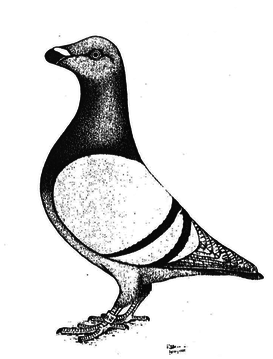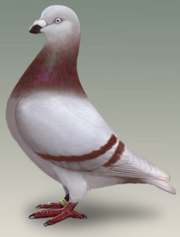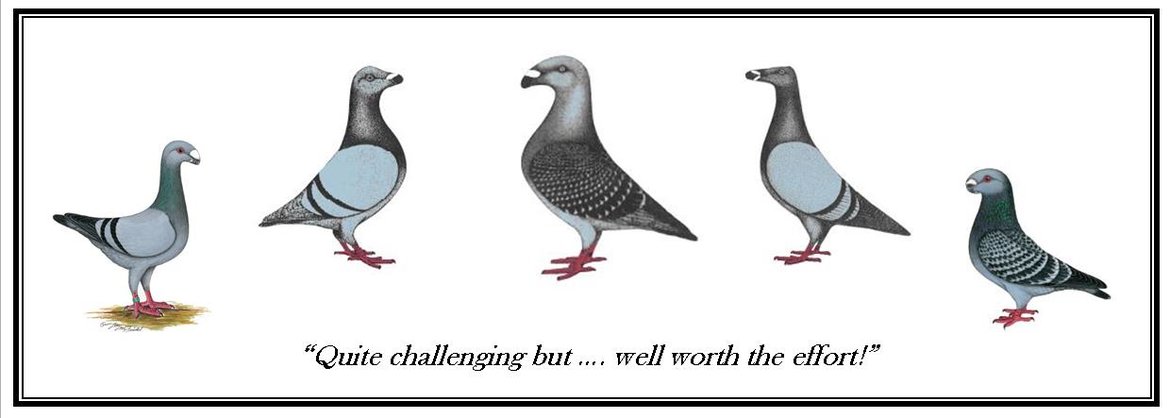Genuine Homer EE Standard

The United Fancy Homer Club(UK).
GENUINE HOMER (EE Standard)
Origin: England. Developed from the Racing Homer, a purely exhibition pigeon was created in the early part of this century. Claimed by Clements in 1936 to have been bred from Show, Exhibitions Homers and Dragoons. First Breed Club formed in 1906.
Overall Impression: Short in body, broad shoulders, deep keel, presenting a wedged shaped appearance, medium in size and excessive in no property, hard and close feathered, alert and watchful.
Characteristics of Breed:
Size: Medium in size, every point being in proportion.
Head: In profile rising gradually and almost imperceptibly from the back of the wattle to immediately before the eye, being the highest point.
The head should show no angularity or flatness, the whole giving the appearance of nice straight-faced bird.
With nothing of the sweep or flatness of the Show/Exhibition Homer, then descending to the neck without exhibiting a broken line.
The top view should show fairly broad between the eyes narrowing towards the wattle.
Eyes: The eye to be white, bold, alert and full of intelligence.
Eye Ceres: Small, hard and finely laced. Black is the preferred colour. In pied varieties, a part coloured cere is admissible.
Beak: To be stout and rather blunt, the upper and lower mandibles to be as near as equal in strength, maximum length from tip of beak to centre of eye not to exceed 1 5/8” inches to 1 ¾ “inches (41mm to 45mm)
A hard dark colour of beak, black preferred, in Pied a part coloured beak is admissible.
Wattles: To be V-shaped, small and fine in texture.
Throat: The throat should be free from gullet.
Neck: The neck should be of minimum length and thickness and gradually widening from head to body.
Chest: Broad and full.
Back: Short and flat. Broad across shoulders, tapering off to the rump, which should be well covered.
Body: Deep in keel, short and straight in breastbone, plenty of front and finishing in a wedge shape.
Wings: To have powerful and prominent butts, the flights strong and broad, closely overlapped and carried above tail.
Tail: To be closed fitting and consist of ten to twelve feathers and have the appearance of one feather. To be carried clear of the ground, and somewhat short in proportion to the size of the bird, and extend slightly beyond the flights.
Legs: Fairly short, well set back and of medium thickness.
Plumage: The feathers should be hard and close fitting and in great condition.
Stance/Carriage: Bold and alert.
Recognised Colours: Blue, black, red and yellow chequers. Chequering should be clear and distinctive throughout.Blue, mealy, silver, cream and indigo bars with two broad, well defined bars on the wings. There are grizzles, spread ash reds, self blacks and andalusians.Pieds in all colours accepted.Sound, bright colours and not having a washed out appearance.
Serious Faults: Thin, open or wry beak. Coarse or ill shaped wattles. Soft pale cere. Red/lemon gravel or hard eye. Thick throat or gullet. Frill or open feathered neck, long swan neck. Long shaped body, curved back. Crooked breast bone. Feathered legs or toes. Heavy or wry tail. Long legs, webbed feet, crooked claws or toes.
Order of Importance: It is vital importance that the highest standard should be obtained in a typical Genuine Homer. Quality depends on a general combination of the chief characteristics. Birds when exhibited should be in perfect natural condition.Benefical preparation of an exhibit should be encouraged.
Judging:
Scale of Points:
Beak and wattle 10 points.
Eye and cere 10 “
Head/skull 10 “
Outlook & stance 10 “
Neck 5 “
Body 20 “
Legs 5 “
Feather 10 “
Colour 10 “
Condition 10 “
TOTAL 100 POINTS
Ring Size 10mm (UK size D)
Year of publication Re-formatted to meet EE- Standard model on 28th December 2011, at the AGM of the United Fancy Homer Club.
Breed Grouping Wattle/Head.
"Quite Challenging ......... but well worth the effort!"
Contact Us

